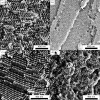Multicomponent Nanomaterials with Complex Networked Architectures from Orthogonal Degradation and Binary Metal Backfilling in ABC Triblock Terpolymers
- PMID: 25836760
- PMCID: PMC4434530
- DOI: 10.1021/jacs.5b01915
Multicomponent Nanomaterials with Complex Networked Architectures from Orthogonal Degradation and Binary Metal Backfilling in ABC Triblock Terpolymers
Abstract
Selective degradation of block copolymer templates and backfilling the open mesopores is an effective strategy for the synthesis of nanostructured hybrid and inorganic materials. Incorporation of more than one type of inorganic material in orthogonal ways enables the synthesis of multicomponent nanomaterials with complex yet well-controlled architectures; however, developments in this field have been limited by the availability of appropriate orthogonally degradable block copolymers for use as templates. We report the synthesis and self-assembly into cocontinuous network structures of polyisoprene-block-polystyrene-block-poly(propylene carbonate) where the polyisoprene and poly(propylene carbonate) blocks can be orthogonally removed from the polymer film. Through sequential block etching and backfilling the resulting mesopores with different metals, we demonstrate first steps toward the preparation of three-component polymer-inorganic hybrid materials with two distinct metal networks. Multiblock copolymers in which two blocks can be degraded and backfilled independently of each other, without interference from the other, may be used in a wide range of applications requiring periodically ordered complex multicomponent nanoarchitectures.
Figures







Similar articles
-
Core-shell-corona polymeric micelles as a versatile template for synthesis of inorganic hollow nanospheres.Acc Chem Res. 2014 Jan 21;47(1):157-67. doi: 10.1021/ar4001026. Epub 2013 Aug 20. Acc Chem Res. 2014. PMID: 23962222
-
Polydispersity effects in poly(isoprene-b-styrene-b-ethylene oxide) triblock terpolymers.J Chem Phys. 2009 Jun 21;130(23):234903. doi: 10.1063/1.3140205. J Chem Phys. 2009. PMID: 19548752
-
Graded porous inorganic materials derived from self-assembled block copolymer templates.Nanoscale. 2015 Mar 19;7(13):5826-34. doi: 10.1039/c4nr07492k. Nanoscale. 2015. PMID: 25758193
-
DNA block copolymers: functional materials for nanoscience and biomedicine.Acc Chem Res. 2012 Sep 18;45(9):1419-30. doi: 10.1021/ar200211a. Epub 2012 Jun 22. Acc Chem Res. 2012. PMID: 22726237 Review.
-
Advances in PEG-based ABC terpolymers and their applications.RSC Adv. 2020 Jun 5;10(36):21602-21614. doi: 10.1039/d0ra03478a. eCollection 2020 Jun 2. RSC Adv. 2020. PMID: 35518773 Free PMC article. Review.
Cited by
-
Zinc versus Magnesium: Orthogonal Catalyst Reactivity in Selective Polymerizations of Epoxides, Bio-derived Anhydrides and Carbon Dioxide.Chemistry. 2017 Mar 28;23(18):4260-4265. doi: 10.1002/chem.201605690. Epub 2017 Mar 15. Chemistry. 2017. PMID: 28295663 Free PMC article.
-
Di-Zinc-Aryl Complexes: CO2 Insertions and Applications in Polymerisation Catalysis.Chemistry. 2017 May 29;23(30):7367-7376. doi: 10.1002/chem.201701013. Epub 2017 May 5. Chemistry. 2017. PMID: 28370511 Free PMC article.
-
One-pot synthesis of hyperbranched polymers via visible light regulated switchable catalysis.Nat Commun. 2023 Mar 23;14(1):1622. doi: 10.1038/s41467-023-37334-x. Nat Commun. 2023. PMID: 36959264 Free PMC article.
-
Soft self-assembly of Weyl materials for light and sound.Proc Natl Acad Sci U S A. 2018 Apr 17;115(16):E3655-E3664. doi: 10.1073/pnas.1720828115. Epub 2018 Apr 2. Proc Natl Acad Sci U S A. 2018. PMID: 29610349 Free PMC article.
-
A vesicle-aggregation-assembly approach to highly ordered mesoporous γ-alumina microspheres with shifted double-diamond networks.Chem Sci. 2018 Aug 17;9(39):7705-7714. doi: 10.1039/c8sc02967a. eCollection 2018 Oct 21. Chem Sci. 2018. PMID: 30393532 Free PMC article.
References
-
- Meuler A. J.; Hillmyer M. A.; Bates F. S. Macromolecules 2009, 42, 7221–7250.
-
- Bates F. S.; Fredrickson G. H. Phys. Today 1999, 52, 32–38.
-
- Templin M.; Du Chesne A.; Franck A.; Leist H.; Zhang Y.; Ulrich R.; Shadler V.; Wiesner U. Science 1997, 278, 1795–1798. - PubMed
-
- Yang P.; Deng T.; Zhao D.; Feng P.; Pine D.; Chmelka B. F.; Whitesides G. M.; Stucky G. D. Science 1998, 282, 2244–2246. - PubMed
-
- Gier T. E.; Bu X.; Feng P.; Stucky G. D. Nature 1998, 395, 154–157.
LinkOut - more resources
Full Text Sources
Other Literature Sources

